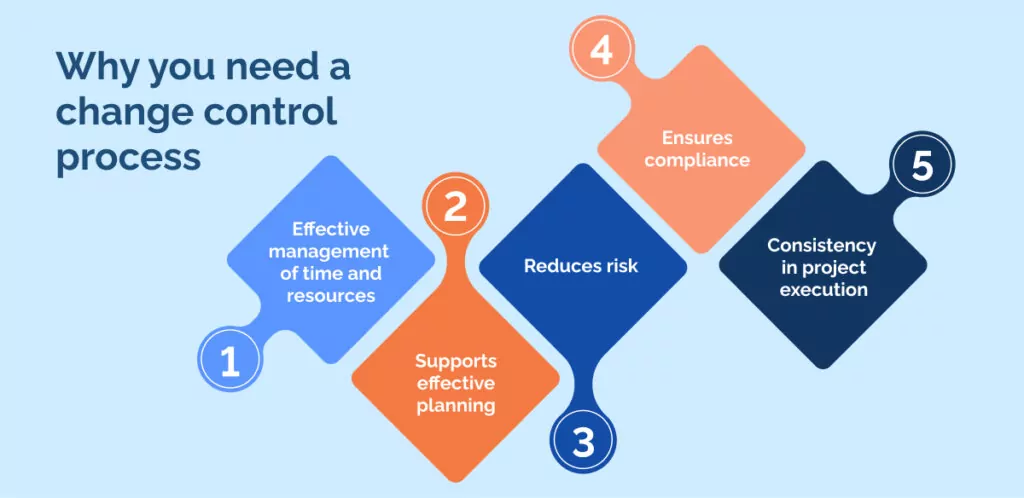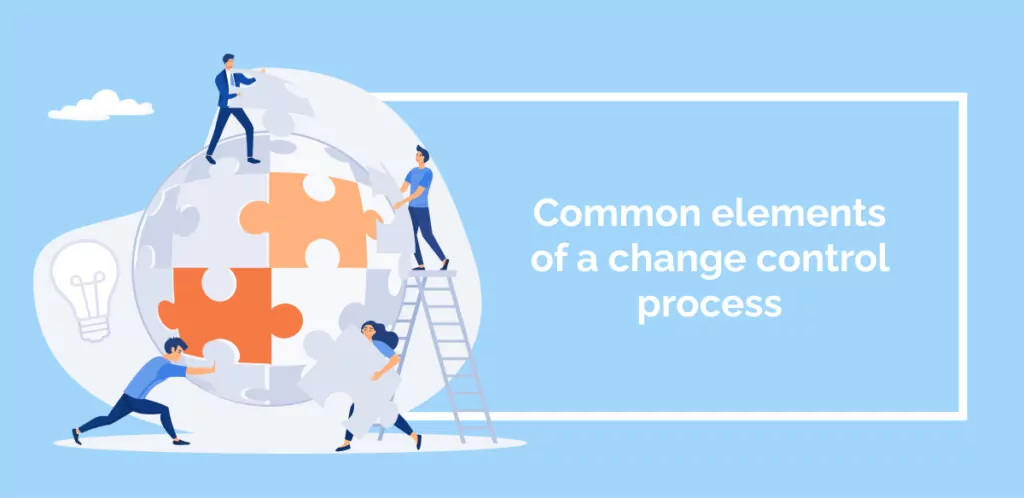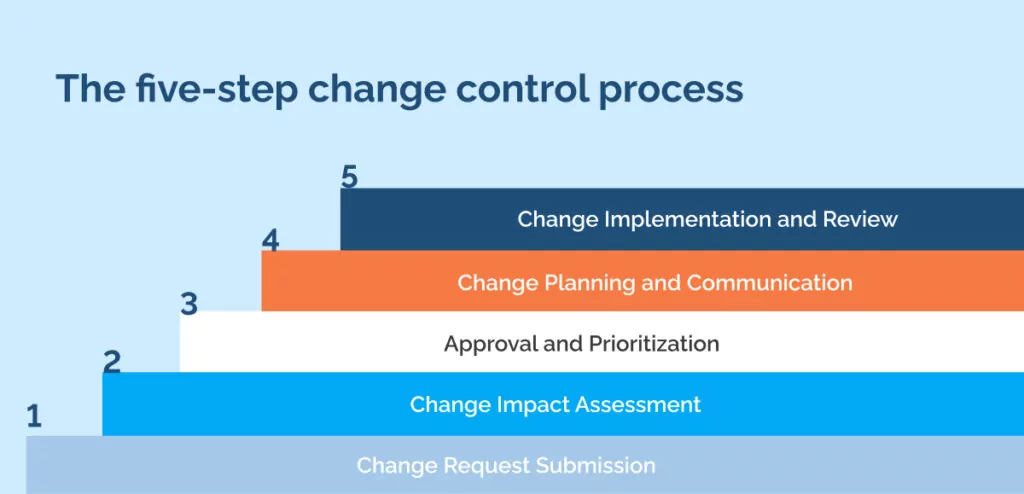
A change control process is the steps you take to implement specific changes to a plan, product, or strategy. Every organization treats change control differently. A typical change process will usually include elements such as a change request, impact assessment, authorization, documentation, and review.
A change control process is a very important part of project management. Staff and stakeholders will always need to make changes to an initial brief. But if you don’t have a proper process for those changes, the brief can get distorted. A bad process costs time and money, and limits your outcomes.
To help make sense of change control, in this article we will explain the change control process from the ground up.
We will start by explaining the definition of the change control process, and assess its purpose. We will then introduce a wide variety of features that you might see in a change control process, before describing one set of steps you might take. Finally, we will take a look at three exemplary systems for managing change control.
Change control may seem to be just another piece of paperwork to get right. But it’s the kind of process that supports good change managers – so there’s no excuse for ignoring it!
What is the change control process?
Change is almost inevitable, even in the best-planned projects out there. After the project plan has started, there will be corrections, revisions, modifications, additions, and more. Those changes could come from any level in the business, with a wide range of rationales, and may even contradict one another.
That’s where the change control process comes in.
Change control helps project managers to make sensible choices about adjustments. The change control process puts several stages of paperwork in place to help leaders and managers cautiously adjust their projects. It helps them understand whether a change is necessary or achievable, who needs to know about it, and much more.
In short, change control minimizes the disruption from various changes, and helps projects to achieve their goals. That’s why Jane Suchan has said that a change control process “can be a project manager’s best friend“.
Change control can, at times, be referred to by different terms – variation management, revision management, change request management, or others.
Many of these different descriptions can be used interchangeably, without harm coming to users. But in our view, it’s important to distinguish the specific steps of change control from the practice of change management.
Why you need a change control process

To put it simply, companies implement change control processes to maximize results and minimize inefficiencies. A successful change control process will help leaders to monitor changes and intervene whenever appropriate.
In this section, we will introduce the five major reasons for using a good change control process. They are effective resource allocation; improved planning; better risk management plans; legal compliance; and consistency.
- Effective management of time and resources
The project’s time and resources are carefully allocated in the initial plan. When you make changes along the way, you risk wasting those resources on activities that don’t serve the end results. As Anthony Camputo explains, “You must recognize that any work beyond what was originally designed will devour time and resources from the actual work scheduled to be done or goods to be delivered.”
This is not intuitive. But a ruthless control on change requests will make your budget much easier to manage.
- Supports effective planning
The change control process supports effective planning by systematically evaluating proposed changes, identifying potential risks, allocating appropriate resources, and integrating changes into existing project timelines.
It enables organizations to make informed decisions, anticipate challenges, and develop contingency plans, ensuring that changes are well-managed and aligned with project goals. Through comprehensive documentation and communication, stakeholders are aware of planned changes and their implications, leading to more efficient and successful project execution.
- Reduces risk
The change control process reduces risk in project management by providing a systematic approach to assess and manage proposed changes. It ensures that changes are thoroughly evaluated for potential impacts on project scope, schedule, and resources, enabling project managers to make informed decisions.
By identifying risks early on and implementing risk mitigation strategies, the change control process minimizes the chances of unforeseen issues, delays, and disruptions, leading to a more controlled and successful project outcome.
- Ensures compliance
The change control process ensures compliance with regulatory matters by systematically identifying and assessing regulatory requirements relevant to the proposed changes. It incorporates regulatory expertise, obtains necessary approvals, and maintains comprehensive documentation, thereby facilitating adherence to applicable laws, industry standards, and safety regulations throughout the change implementation.
This process helps mitigate the risk of non-compliance, ensuring that the organization meets its regulatory obligations and avoids potential legal and reputational consequences.
- Consistency in project execution
The change control process ensures consistency by establishing a standardized approach to evaluating, approving, and implementing changes. It requires a systematic assessment of proposed changes, ensuring that all modifications undergo a thorough and uniform evaluation process.
By maintaining a consistent framework for decision-making and documentation, the change control process helps minimize variations in change management practices, leading to greater reliability, predictability, and continuity in project outcomes.
Common elements of a change control process

Change control is a thorough (but challenging!) mechanism for fragmented teams.
It’s no surprise that there are many different ways of constructing a perfectly good change control process – in one useful analysis, a team from the UK analyzed seven change control methods in construction projects.
To help give you an overview of the topic, here’s a list of all the different elements you might see in a process. If you’re developing your own in-house methods of dealing with change requests, you can choose the necessary parts from the list.
(If you’re still looking for the simplest version, you can head straight to our next section ‘The five-step change control process’) below.
- Change Request Form: A standardized form for submitting change requests, including details like the reason for the change, description, potential impacts, and proposed solutions.
- Change Control Board (CCB): A group of relevant stakeholders responsible for reviewing and approving or rejecting change requests.
- Change Impact Assessment: An evaluation of the potential impact of the proposed change on project scope, schedule, budget, resources, and stakeholders.
- Risk Assessment: Identification and analysis of risks associated with the proposed change, including potential positive and negative consequences.
- Change Prioritization: Ranking and prioritizing change requests based on factors like urgency, business value, and risk.
- Change Authorization: Formal approval process, including necessary sign-offs and authorizations from appropriate authorities.
- Change Planning: Developing a detailed plan for implementing approved changes, including tasks, timelines, and resource allocation.
- Change Communication Plan: A strategy for communicating proposed changes to stakeholders, ensuring everyone is informed about the change and its impact.
- Testing and Validation: Conducting tests to verify that the change functions as intended and doesn’t negatively impact existing systems or processes.
- Rollback Plan: A contingency plan to revert to the previous state in case the change doesn’t yield the desired results or causes unexpected issues.
- Documentation Management: A system for recording and organizing all change-related documentation, including request forms, evaluations, approvals, and outcomes.
- Training and Knowledge Transfer: Ensuring that relevant team members receive adequate training and knowledge transfer to handle and support the change effectively.
- Change Implementation: Executing the approved changes in a controlled manner, following the designated plan.
- Post-Implementation Review: A review after the change is implemented to assess its success and any lessons learned.
- Change Closure: Formal closing of the change request and its associated documentation.
- Audit and Compliance: Ensuring that the change control process complies with internal and external regulations, and is subject to periodic audits.
- Continuous Improvement: Analyzing the change control process regularly to identify opportunities for improvement and refining the process based on feedback and experience.
- Integration with Project Management: Aligning the change control process with the organization’s overall project management framework for seamless integration with project plans and schedules.
- Standard Operating Procedures (SOPs): Developing SOPs to provide step-by-step instructions for executing the change control process consistently.
- Change Metrics and Reporting: Establishing performance metrics to measure the success and effectiveness of the change control process and generating regular reports for stakeholders.
- Feedback Mechanism: Implementing a feedback mechanism to capture and address any concerns or suggestions related to the change control process.
The five-step change control process

There are many ways to implement an effective change control process. Indeed, many companies choose to develop their own internal systems.
To give you a starting point, this section will introduce a five-step control process – running from the change request, to change implementation.
Step 1: Change Request Submission
- Employees or stakeholders submit change requests using a standardized form, providing a clear description of the change, its purpose, potential benefits, and any associated risks.
Step 2: Change Impact Assessment
- A designated Change Control Board (CCB) or review team evaluates the change requests to assess their potential impact on the organization. This includes examining the implications on project scope, schedule, resources, budget, and compliance with regulatory requirements.
Step 3: Approval and Prioritization
- The CCB or review team prioritizes change requests based on urgency, business value, and risk. Approved changes are assigned to relevant resources or teams for implementation.
Step 4: Change Planning and Communication
- The approved changes are thoroughly planned, including the development of a detailed implementation plan, resource allocation, testing, and a rollback strategy. Stakeholders are informed about the changes, their objectives, and any actions they need to take.
Step 5: Change Implementation and Review
- The changes are executed following the designated plan, and their implementation is closely monitored. After the changes are in place, a post-implementation review is conducted to assess their success, gather feedback, and identify any areas for improvement.
This simplified five-step change control process provides a systematic approach to managing changes, ensuring consistency, and promoting successful outcomes across various business environments. It allows for effective evaluation and prioritization of changes while maintaining transparency and clear communication with stakeholders throughout the process.
Conclusion
In this article, we’ve introduced the core features of change control processes.
A change control process helps every project to stay on the right track. Although there are many different aspects that can feature in a change control process, five steps are enough to stay strong on change control.
In the future, change control can be handled more and more effectively with technology and AI. Indeed, a 2023 article on AI in project management highlights change visibility as one of the most valuable functions of a cutting-edge project management system.
Digital transformation can help with this. But you need to have change control processes set up in the first place. Take a look at your organization’s methods, and see what changes you can make today.
WalkMe Team
WalkMe spearheaded the Digital Adoption Platform (DAP) for associations to use the maximum capacity of their advanced resources. Utilizing man-made consciousness, AI, and context-oriented direction, WalkMe adds a powerful UI layer to raise the computerized proficiency, everything being equal.



